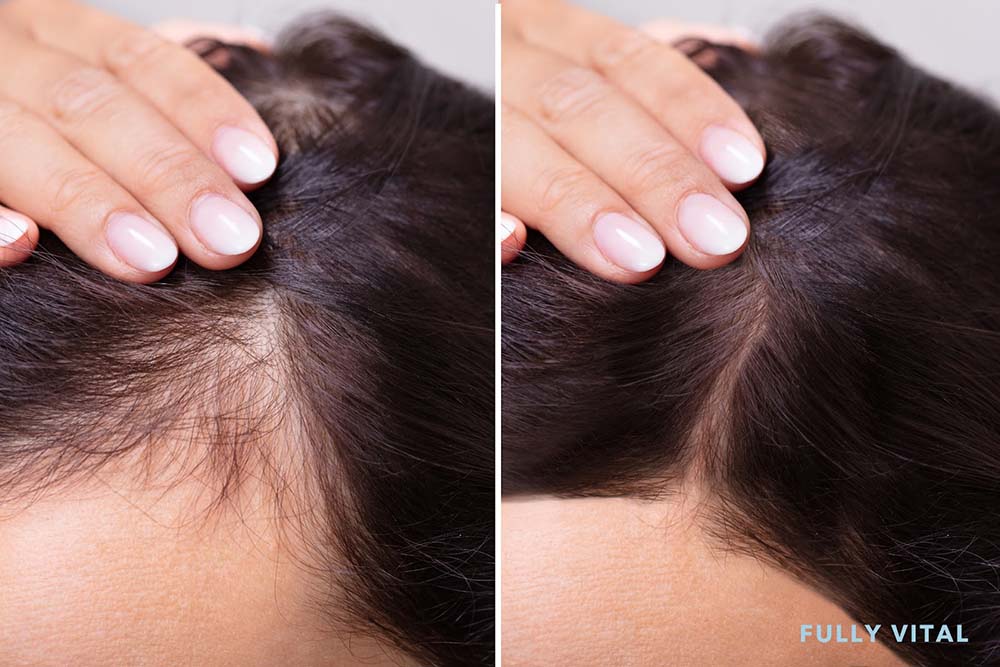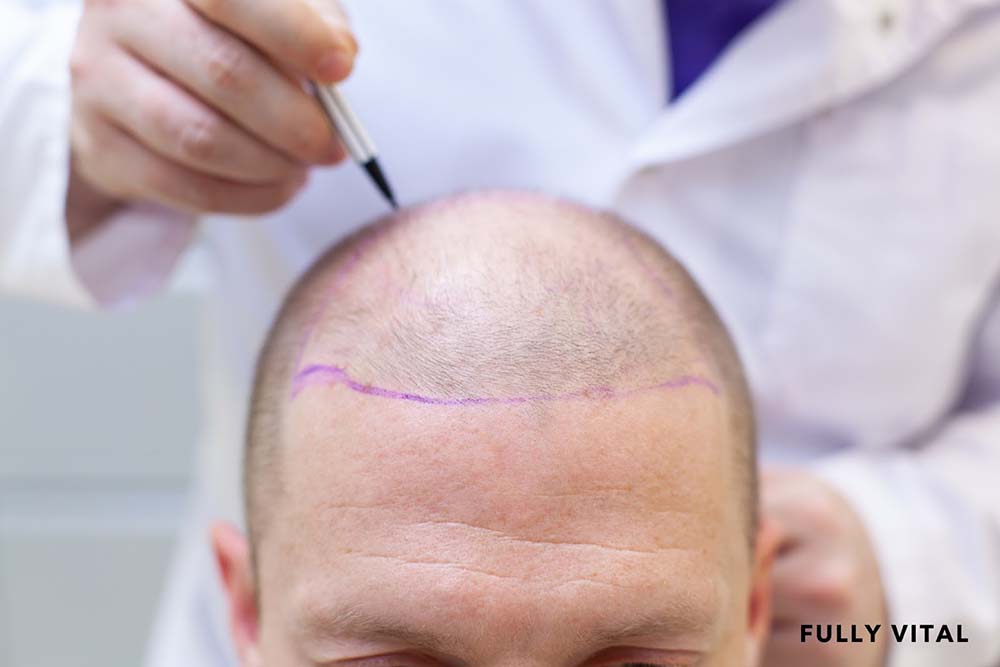
Hair Replacement: Surgical and Non-Surgical Methods
Are you tired of dealing with hair loss and thinning hair, and are seeking a solution to promote hair growth and regain your confidence? Hair replacement might be the answer you've been looking for! In this article, we'll cover everything you need to know about hair replacement, its benefits, downsides, alternatives, and more.
So, let's dive in and explore how you can achieve a beautiful and voluminous head of hair.

I LOVE MY HAIR NOW
FullyVital hair serum and hair vitamins made tremendous improvements in my hair. I truly love my hair now.
Dorit S.,
What Is Hair Replacement?
Hair replacement is a revolutionary procedure designed to address hair loss and baldness.
It involves the restoration of hair in areas where thinning or balding has occurred.
The goal is to provide a natural-looking solution that blends seamlessly with your existing hair, boosting your confidence and enhancing your overall appearance.

Why Is Hair Replacement Important?
Hair loss can be emotionally distressing, affecting self-esteem and self-image.
For women of all hair types, experiencing hair loss can be particularly challenging.
Hair replacement is essential because it allows you to take control of your appearance and feel more comfortable in your own skin.
By addressing hair loss, you can regain your youthful look and maintain a positive self-image.
How Does Hair Replacement Work?
Hair replacement primarily involves two main methods: hair transplantation and non-surgical hair replacement.
Hair Transplantation
Hair transplantation is a surgical procedure where hair follicles are harvested from one part of your body, typically the back or sides of your scalp (donor area), and carefully transplanted into the areas with thinning or no hair (recipient area).1
These transplanted hair follicles continue to grow naturally in their new location, resulting in a permanent solution to hair loss.
Non-Surgical Hair Replacement
For those seeking a non-invasive and more affordable option, non-surgical hair replacement methods offer an excellent alternative.
These methods include hairpieces, wigs, and extensions.
Modern technology has made significant advancements, ensuring that non-surgical options provide a natural appearance that is virtually indistinguishable from your real hair.
What Are The Benefits Of Hair Replacement?
Hair replacement offers numerous benefits that can positively impact your life:
Improved Appearance
Hair replacement gives you the opportunity to achieve a full head of hair, significantly enhancing your overall appearance.2
Permanent Solution
With hair transplantation, the transplanted hair continues to grow naturally, providing a long-lasting and permanent solution to hair loss.
Boost In Confidence
Restoring your hair can boost your confidence and self-esteem, making you feel more attractive and self-assured.
Natural Look And Feel
Both surgical and non-surgical hair replacement methods result in a natural look and feel, allowing you to style your hair as you desire.
Suitable For All Hair Types
Hair replacement is suitable for women of all hair types, including straight, wavy, curly, or coily hair.
Are There Any Downsides To Hair Replacement?
While hair replacement has many advantages, it's crucial to consider some potential downsides:
Cost
Hair replacement procedures, especially surgical options like hair transplantation, can be expensive.
Maintenance
Non-surgical hair replacement methods may require regular maintenance and care to ensure they look their best.
Risk Of Infection
As with any surgical procedure, there is a slight risk of infection, although it's rare when performed by a skilled professional.
What Are The Alternatives To Hair Replacement?
If hair replacement doesn't align with your preferences or budget, several alternatives can help stimulate hair growth:
Hair Growth Products
Consider using hair growth shampoos, conditioners, serums, and supplements.
Look for products containing ingredients like biotin, minoxidil, and keratin.
Lifestyle Changes
Adopt a healthy lifestyle, including a balanced diet rich in essential nutrients, regular exercise, and stress management.3
Platelet-Rich Plasma (PRP) Therapy
This innovative procedure involves injecting your blood's plasma into your scalp to promote hair growth.
Low-Level Laser Therapy (LLLT)
LLLT devices, such as laser combs or helmets, use low-level lasers to stimulate hair follicles and encourage hair growth.
What Is The History Of Hair Replacement?
Hair replacement is not a new concept; it has a rich history that dates back centuries.
Throughout the years, various methods and techniques have been developed to address hair loss and promote hair growth.
Here's a brief overview of the history of hair replacement:
-
Ancient Times: Historical records show that ancient civilizations, such as the Egyptians and Greeks, experimented with various remedies and herbal treatments to combat hair loss.
-
Wigs and Hairpieces: Wigs have been used for centuries to enhance appearance, especially during the Renaissance and the Victorian era. They served as a fashionable accessory and a way to hide hair loss.
-
Early Surgical Methods: In the early 19th century, surgical techniques to transplant hair were attempted, but they were not very successful.
-
Modern Hair Transplantation: Hair transplantation, as we know it today, was revolutionized in the mid-20th century. Dr. Norman Orentreich is credited with performing the first successful hair transplant in the 1950s, laying the foundation for modern hair restoration techniques.
-
Advancements in Technology: Over the years, advancements in technology, such as follicular unit transplantation (FUT) and follicular unit extraction (FUE), have significantly improved the outcomes of hair replacement procedures.
Our Best Sellers
What Is The Current Environment Of Hair Replacement?
In the present day, hair replacement has become a widely sought-after solution for men and women experiencing hair loss.
The current environment of hair replacement is marked by:
-
Increased Awareness: There is a growing awareness of hair replacement options and their effectiveness in restoring natural-looking hair.
-
Advancements in Non-Surgical Options: Non-surgical hair replacement methods, such as wigs, hairpieces, and extensions, have seen significant advancements in terms of realism and comfort.
-
Customization: Hair replacement solutions are now highly customizable to meet the unique needs and preferences of individuals, including different hair types and styles.
-
Growing Acceptance: As celebrities and public figures openly discuss their experiences with hair replacement, there is a reduction in stigma surrounding the topic, leading to increased acceptance.
What Is The Future Of Hair Replacement?
The future of hair replacement holds even more promise, with ongoing research and advancements in technology.
Here are some potential developments to look forward to:
-
Regenerative Medicine: Scientists are exploring regenerative medicine techniques that may lead to hair follicle regeneration, offering a more natural and sustainable solution for hair loss.
-
Stem Cell Therapy: Stem cell therapy shows promise in stimulating hair growth by using a patient's own stem cells to rejuvenate hair follicles.
-
Improved Surgical Techniques: Surgical hair replacement methods are likely to become more refined and efficient, with reduced recovery times and enhanced outcomes.
-
Biotechnology and Genetics: Biotechnology may unlock new ways to target the genetic factors contributing to hair loss, leading to more personalized and effective treatments.
-
Non-Invasive Treatments: Non-surgical options may advance further, offering even more realistic and comfortable solutions for hair loss.
How Long Does It Take To See Results From Non-Surgical Hair Replacement?
Non-surgical hair replacement offers a quicker turnaround time compared to surgical procedures.
While individual results may vary, most individuals can start seeing noticeable improvements within a few weeks to a couple of months.
Here's what you can expect during the process:
-
Immediate Aesthetics: Once the hairpiece or wig is fitted and styled, you'll see an instant improvement in your appearance.
-
Hair Adaptation: It may take a few days for you to get used to the new hairpiece, but with time, you'll become more comfortable and confident with your new look.
-
Full Adjustment: Within a few weeks, you'll have fully adapted to your non-surgical hair replacement, and it will feel like a natural part of you.
Remember that proper care and maintenance are essential to ensuring the longevity and optimal appearance of your non-surgical hair replacement.
Are There Any Side Effects Associated With Hair Transplantation?
While hair transplantation is generally safe, like any surgical procedure, it does carry some potential side effects.
These side effects are typically mild and temporary, and most people recover well after the procedure.
Potential side effects include:
-
Swelling: Some temporary swelling may occur in the recipient area and the forehead, but it usually subsides within a few days.
-
Bleeding: Minor bleeding at the donor and recipient sites is normal during the initial days after the surgery.
-
Scarring: Hair transplantation leaves minimal scars, which are usually tiny and well-hidden.
-
Infection: Although rare, there is a small risk of infection. Following post-operative care instructions is essential to minimize this risk.
-
Shock Loss: Some patients may experience temporary hair shedding around the transplanted area, but the hair will grow back within a few months.
It's crucial to choose a skilled and experienced hair specialist to minimize the risk of side effects and ensure a successful outcome.
Can Hair Replacement Be Performed On Women With Afro-Textured Hair?
Yes, hair replacement procedures can be performed on women with Afro-textured hair.
Hair transplantation is suitable for individuals with different hair types, including curly and coily hair.
Skilled surgeons can harvest hair follicles from the donor area, which may have a similar texture to Afro-textured hair, and transplant them into the recipient area.
With proper care and styling, the transplanted hair will blend seamlessly with your natural hair, providing a beautiful and natural-looking result.
Will Hair Replacement Procedures Interfere With My Natural Hair Growth?
Hair replacement procedures, whether surgical or non-surgical, do not interfere with your natural hair growth.
In fact, hair transplantation uses your own hair follicles from the donor area, ensuring that the transplanted hair continues to grow naturally in its new location.
For non-surgical options like wigs and hairpieces, they do not affect your natural hair growth as they are simply attached to the existing hair.
How Do I Find A Reputable Hair Specialist Or Clinic For Hair Replacement?
Finding a reputable hair specialist or clinic is crucial to the success of your hair replacement journey.
Follow these steps to find the right expert for you:
-
Research: Conduct thorough research and read reviews about various hair specialists or clinics in your area.
-
Credentials: Check the credentials, qualifications, and experience of the hair specialist. Look for certifications and affiliations with reputable organizations.
-
Before and After Photos: Review before and after photos of previous patients to gauge the quality of their work.
-
Consultation: Schedule a consultation with the hair specialist to discuss your concerns and desired outcomes.
-
Client Testimonials: Seek recommendations from friends, family, or online communities who have undergone hair replacement procedures.
Unlock the Secret to Youthful Hair with Fully Vital's Powerful Hair Growth Products!Are you tired of dealing with hair loss and the signs of aging in your locks? At Fully Vital, we understand the importance of a healthy relationship with your hair. That's why we've developed a variety of science-backed hair growth products that can help you slow down and reverse the aging of your hair. Key Features:
Benefits:
|
Final Thoughts On Hair Replacement
Hair replacement is a game-changing solution for women of all hair types seeking to stimulate hair growth and regain their confidence.
Whether you opt for surgical procedures like hair transplantation or prefer non-surgical methods like wigs and hairpieces, the benefits of hair replacement are undeniable.
It's an essential choice for those looking to address hair loss and achieve a fuller, more vibrant head of hair.
At Fully Vital, we understand the significance of a healthy relationship with your locks.
Our mission is to empower you with powerful, science-backed hair growth products that can slow down and reverse the aging of your hair.
From shampoos and conditioners to serums and supplements, our variety of solutions caters to your unique needs, ensuring you experience the joy of having youthful, vibrant hair.
Frequently Asked Questions About Hair Replacement
How long does a hair transplantation procedure take?
The duration of a hair transplantation procedure varies, but it typically takes several hours to complete, depending on the extent of hair loss and the number of grafts needed.
Is hair replacement painful?
Hair replacement procedures are usually performed under local anesthesia, so you should not experience significant pain during the process.
Some mild discomfort or soreness may be expected in the days following a hair transplant.
How soon can I resume regular activities after a hair transplant?
You can typically resume regular activities within a few days after the procedure, but it's essential to follow your surgeon's post-operative instructions to ensure proper healing.
Can I style my hair as usual with non-surgical hair replacement?
Yes, you can style your hair as you would with your natural hair when using non-surgical hair replacement methods.
Styling options may vary depending on the type of hairpiece or wig you choose.
Are hair growth products safe for all hair types?
Hair growth products are generally safe for all hair types, but it's essential to check the ingredients and do a patch test if you have a history of allergies or sensitive skin.
Will people be able to tell that I'm wearing a wig or hairpiece?
Modern advancements in wig and hairpiece technology ensure that these options look incredibly natural.
When properly fitted and styled, it's challenging for others to notice any difference.
Am I a suitable candidate for hair transplantation?
The suitability for hair transplantation depends on various factors, including the extent of hair loss, the availability of donor hair, and overall health.
Consult with a hair specialist to determine if you are a good candidate for the procedure.
Is there any downtime after a hair transplantation?
After a hair transplantation, there might be some redness and mild swelling in the recipient area.
These usually subside within a few days, and you can typically return to work and regular activities shortly after the procedure.
Can hair replacement procedures correct receding hairlines?
Yes, hair transplantation can effectively address receding hairlines.
Skilled surgeons can strategically transplant hair follicles to create a natural-looking hairline that complements your facial features.
Will the transplanted hair require any special care?
The transplanted hair will require similar care to your natural hair.
Follow your surgeon's instructions for the post-operative care of the recipient area, and once the transplanted hair grows, maintain a regular hair care routine.
Sources:
-
Hair Transplantation: Practice Essentials, Background, Anatomy. (2022). EMedicine. https://emedicine.medscape.com/article/839753-overview?form=fpf
-
Hair Replacement | Academy Of Plastic Surgery. (n.d.). Www.academyofplasticsurgery.co.za. Retrieved August 4, 2023, from https://www.academyofplasticsurgery.co.za/hair-replacement
-
Tamanal, J. M., & Kim, C. H. (2020). Promoting Healthy Lifestyle in High School Students: Determination of the Lifestyle Status through the Healthy Lifestyle Screen (HLS) Assessment. Journal of Lifestyle Medicine, 10(1), 30–43. https://doi.org/10.15280/jlm.2020.10.1.30







